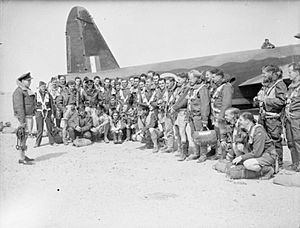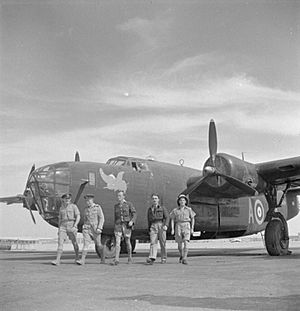No. 108 Squadron RAF facts for kids
Quick facts for kids No. 108 Squadron RAF |
|
|---|---|
| Active | November 1917 – July 1919 January 1937 – March 1945 |
| Country | |
| Branch | |
| Motto(s) | Latin: Viribus contractis ("With gathered strength") |
| Insignia | |
| Squadron Badge heraldry | An oak leaf. This unit was formed at Stonehenge. It chose an oak leaf as its badge to show strength and age. |
| Squadron Codes | 108 (Jan 1937 - Oct 1938) MF (Oct 1938 - Apr 1939) LD (Sep 1939 - Apr 1940) |
No. 108 Squadron RAF was a flying unit that served in the Royal Flying Corps during World War I. It later became part of the Royal Air Force and played a role in World War II. This squadron was known for its bombing and reconnaissance missions.
Contents
World War I Missions
This air force unit started in November 1917. It was formed near Stonehenge in England. The squadron used Airco DH.9 bomber planes.
In July 1918, the squadron moved to Capelle, near Dunkirk. From there, they flew day-bombing missions. Their targets were in north-west Belgium. In October 1918, they moved to Bisseghem, Belgium. They stayed there until the war ended.
During its time overseas, the squadron completed 59 successful bombing raids. They also flew 40 reconnaissance flights. Reconnaissance means gathering information by observing. They dropped about 70 tons of bombs. The squadron also shot down nine enemy aircraft.
After the First World War
No. 108 Squadron was officially stopped in July 1919. It did not exist as a unit for many years.
Reforming for New Challenges
The squadron was started again in January 1937. It was called No. 108 (Bomber) Squadron. This happened at RAF Upper Heyford. Their first planes were Bristol Blenheim Mk. I bombers.
World War II Operations
The day before World War II began, the squadron changed its role. It became a training squadron for new pilots. In April 1940, it joined another training unit. The squadron gave away its Blenheim planes in February 1940. This was to help Finland in the Winter War.
Night Bombing in North Africa
On August 1, 1941, No. 108 Squadron was reformed. This happened at RAF Kabrit in Egypt. It became a night bomber squadron. Their Vickers Wellington planes started bombing raids on September 22. They attacked ports on the Libyan coast and in Greece.
In November, the squadron began to get Consolidated Liberator planes. These large planes flew alongside the Wellingtons until June 1942. On December 18, 1942, the squadron was reduced to a small group. This group was then disbanded on December 25, 1942.
Night Fighter Missions
On March 15, 1943, No. 108 Squadron was reformed again. This time it was at Shandur and became a night fighter squadron. Their Bristol Beaufighter planes flew night patrols. They covered areas over Egypt, Libya, and Malta.
In February 1944, de Havilland Mosquito planes joined them. The Mosquitoes were used for "intruder" missions. This meant they flew into enemy territory to attack. These planes were removed in July. The Beaufighters moved back to Libya. They continued intruder operations over Greece and the Aegean Sea.
Final Missions in Greece
In October 1944, the squadron moved to Greece. They became involved in a conflict there. This was an attempted Communist take-over in December. The squadron attacked rebel positions until the uprising was stopped.
After this, the squadron gave up its aircraft. They sailed to Italy in March 1945. No. 108 Squadron was officially disbanded on March 28, 1945.



